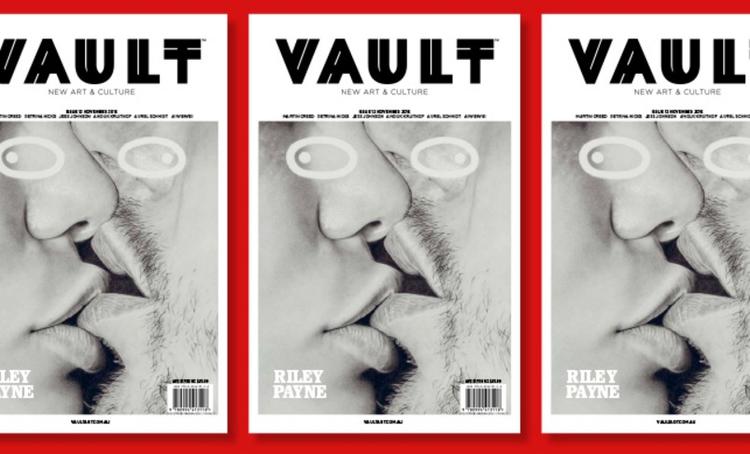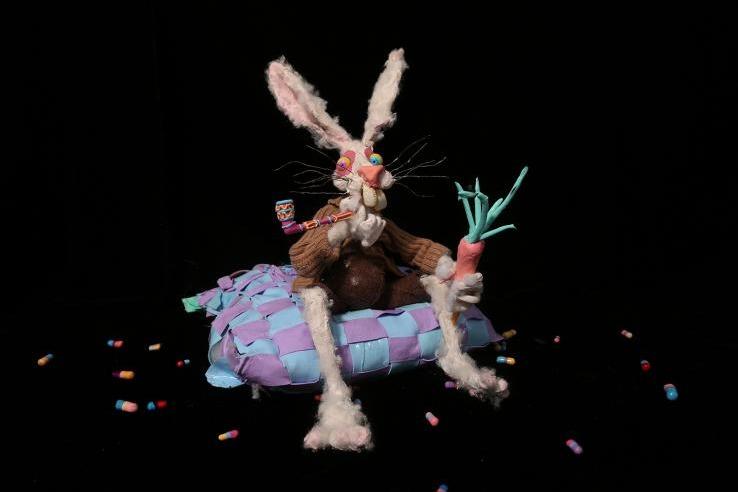First published in VAULT magazine, November 2015.
The claymation films, immersive sculptural installations and throbbing soundscapes of Nathalie Djurberg and Hans Berg ricochet between darkness and light.
There are few litmus tests as profound as the ability to spark laughter. In the art world, nervous giggles and spontaneous guffaws are wrongly dismissed as door prizes for lightweights and populists rather than proof that a work has shaken off the weight of our collective delusions to tap into a powerful cultural vein.
Googling Nathalie Djurberg and Hans Berg, the acclaimed Berlin-based duo whose Claymation videos feel like they were plucked from the Brothers Grimm – if the Brothers Grimm hallucinated a plasticine netherworld in which tigers defile girls’ bottoms, yogis are disembowelled by lustful snakes and children prise their mother’s legs apart to crawl back into their wombs – is a lesson in the fine line between amusement and debasement. The partners and collaborators, who met through friends in 2004, have spent the last decade setting installations that riff on sexuality, violence, bestiality and bloodlust to a jaunty electronic soundtrack. Improbably enough, they’ve also proved that the darkest recesses of humanity can be funny as hell.
“In a way, the humour comes naturally to me,” smiles Djurberg, her fresh-faced Skype visage chasing away my secret fears about the potential progenitor of material this dark. “But I also think that there is something happening when you laugh that cuts through the seriousness and the illusions you may have about something. It makes you more vulnerable. You’re stepping on something that shouldn’t be stepped on. It breaks apart the beliefs that you have.”
“Music is a way to make things lighter,” adds Berg, who runs a parallel career as a respected techno producer and whose heroes include Bjork and Aphex Twin. “I’ve been hammering away on a piano or making music on the synthesizer for as long as I remember and consciously work with the contrast between funny and scary. I think it was David Lynch who once said that those qualities belong together. If it’s just scary, you distance yourself.”
Djurberg and Berg, who trade affectionate glances and regularly finish each other’s sentences, are warm and measured and it’s instantly clear that their body of work isn’t motivated by brashness or a yen for provocation but something altogether richer and more complex. In 2004’s Tiger Licking Girl’s Butt, a clay girl dries herself after a shower in her gelato-coloured bedroom only to find herself confronted by a tiger intent on doling out carnal pleasure. When she lets it climb into her bed, she hints that abject desires and girlish innocence may exist on the same continuum. For the 2009 Venice Biennale, Djurberg and Berg created The Experiment, a three-channel video installation in which robe-clad puppets, whose grotesque faces recall a Goya painting, move from happy camaraderie to games of torture and submission while gargoyle-like flowers – that are meant to evoke a twisted Garden of Eden – bloom all around. The piece, which mines religious hypocrisy as well as the arbitrary nature of good and evil, won Djurberg the Silver Lion award for Most Promising Young Artist and marked the duo out as a singular presence in the art world. And The Parade, a 2012 work shown at New York’s New Museum, sets demonic ostriches and sickly-pink pelicans to Berg’s creepy, electronic loops. He breathes life into Djurberg’s stilted scenarios and turns them into fractured fairytales where moral codes break free from their sugary casing to rival the murkiness of the real world. Unlike the Grimm’s classics, where calm surfaces are a front for sinister realities, there’s something oddly reassuring about this display of excess.
“Hans and I talk a lot about what you’re allowed to do and what you’re not allowed to do and for him, it’s much easier because he has the abstract part,” explains Djurberg, whose 2006 work Natural Selection sees a series of naked, dark-skinned figures forced to parade in front of a shadowy master before they’re accepted into his fold. “I always ask myself the question, ‘am I really allowed to do this, am I allowed to work with things like racism or sexuality or violence?’ But every time you ask yourself that question, you almost have to go ahead and do it because if you don’t your agreeing to society’s terms. For me, I always feel like if you don’t dare to look inside and examine what’s really there or what something is really doing to me, it’s like living with a blindfold on. And if I’m working on something that feels painful, I ask: ‘what would happen if I censored myself? What would that really mean?’”
Djurberg, who was born in Sweden in the late seventies and whose mother briefly ran a puppet theatre, has always seen art as a refuge from cultural mores. “I went to Malmo Art Academy but when I got there, I started questioning why anyone would want to be an artist because it didn’t always pleasurable – for me, art is the part of society that’s supposed to be really free, where you’re supposed to be able to explore things that you otherwise would not,” she recalls. At first, she dabbled in sculpture and painting, but it wasn’t until she taught herself Claymation – a primitive technique that uses stop-motion photography to animate clay figures – that her ideas started to gel. In 2004, she met Berg, a Berlin transplant, through a friend who was convinced that they should work together. “I gave him one of my animations but I didn’t really like the idea of collaborating with anyone,” laughs Djurberg, who had her first solo exhibition at Milan’s Gio Marconi Gallery in 2005 and joined Chelsea art gallery Zach Feuer after a standout show at the Berlin Biennale the following year. “But he really changed it by making this really quirky, super-strange, stupid sort of music. It ended up being something that was actually really good.”
“In the beginning it was just Nathalie’s work and I would add music to it and now it’s a deep collaboration on all levels,” grins Berg, whose soundscapes – which can be soaring, jarring or bone-chillingly eerie – have become as much a character in Djurberg’s menageries as her bulbous mothers, skeletal bunnies and sadistic priests. “The way I work is instinctive and organic and sometimes it enhances what I think is happening and sometimes it goes against it. It’s very hard to get intellectual with music as it steers your emotions so much.”
As the couple’s chemistry has deepened, it’s also worked a curious kind of alchemy on the direction of their work. For instance, The Black Pot, an immersive installation that showed at Moscow’s Garage Centre for Contemporary Art in 2013, saw Djurberg swap the narrative for the abstract, creating neon shapes that morph, move and respond to Berg’s otherworldly compositions. Like The Secret Garden, their upcoming retrospective at the Australian Centre for Contemporary Art in Melbourne, which – according to Berg – uses clay sculptures, light and sound to take audiences deep into their subconscious, the show is less interested in confronting viewers with their own transgressive urges than it is in gently escorting them towards a primordial truth.
“That shift came quite naturally because I had done so many stories to the point that it was no longer interesting to me and I told Hans that I never wanted to do claymation again,” says Djurberg, adding that these days, she works on their projects early in the morning while Berg composes the music late at night. “We had gone back to Hans parents house in Sweden and it was so lonely, there was so much nature and it was so empty that it gave me vertigo. We were down in the basement and we were playing on the theme of creating something from nothing. Then our work became more about going inward and accessing a certain type of mode and consciousness. It was so important for us to pull away from what we are doing.”
But Djurberg, who’s started to re-experimenting with clay puppets, has no intention of relinquishing her commitment to examining the dark side of human desire or bleeding pools of putty on the Disneyfied fables that keep us trapped. “There’s a work called Through the Night Sky Softly by Chris Burden that I’ve always loved, where the artist naked and crawling on glass and it’s such an incredibly strong piece that I keep returning to,” she says, a smile flickering across her face. “Sometimes, Hans and I go and look at art and we’re like “okay, we don’t give a shit about this” but then we also know that it’s not for us. And even though some art can cause pain, I find it so liberating to say things that aren’t sayable. I think that maybe the worst thing is if someone has no reaction to your work at all.”

